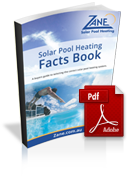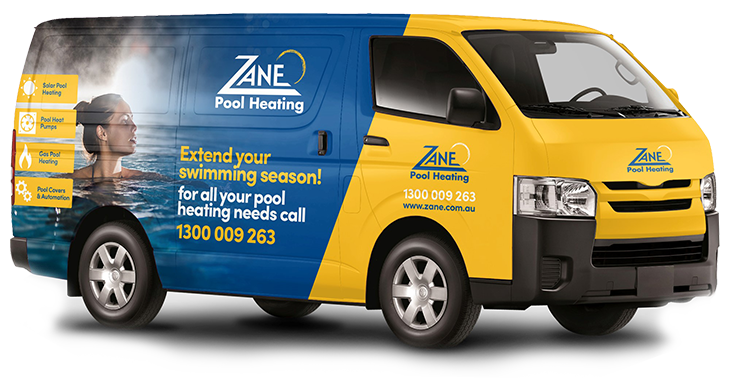Frequently Asked Questions
Why is Zane different?
There are a number of different ways a solar pool heating system can be purchased such as via the Zane Dealer network, retail stores, pool builders, and pool shops. These outlets are able to professionally install your system, guaranteeing you many years of trouble free operation.
The level of protection provided to the purchaser is usually commensurate with the size of the principal supplier and the extent of their involvement in marketing the product by training designers and installers. They should also be engaged directly in the after sales service and warranty activities offered with the product.
In short, the situation is very much “buyer beware” when a product is readily available with no real effort being made to ensure the system design is appropriate and the product is correctly installed and fully operational for the benefit of the end user. If the principal supplier stands behind every aspect of the product, the end user is more likely to end up with a satisfactory result and be afforded a much greater level of protection in terms of workmanship, product warranties and system performance.
Why use a Zane authorised Dealer?
Zane’s solar pool heating systems are only available from Authorised Zane Dealers. This not only ensures every system sold is correctly designed and installed but also serviced by specially trained inspectors.
Correct installation is critical if optimum system performance is to be achieved and the final result is visually pleasing. Consequently, Australian-made Zane is only available from Authorised Zane Dealers. This not only ensures every system sold is correctly designed and installed but also serviced by specially trained inspectors.
Authorised Zane Dealers routinely undertake intensive training to ensure they adhere to the company’s quality controlled design and professional installation practices. In addition, every Zane system is individually inspected with a comprehensive ‘Commissioning Report’ checklist. A Warranty Certificate is then issued by an Authorised Zane Dealer and officially registered on Zane’s central records.
A Zane Authorised Dealer is specially trained to perform the following duties:
- Provide the appropriate solar absorber to achieve the desired result.
- Position the solar collector in the best possible location, preferably a north-facing surface.
- Correctly size pipe work i.e. the manifold pipes feeding water to the solar absorbers, and the delivery and return pipes between the plant room and the roof.
- Correct install the hydraulic arrangement of all pipe work to ensure an even distribution of water to all points in the solar collector array, and eliminate airlocks.
- Provide adequate water flow to the solar collectors, which is a critical part of Zane solar system design. This involves inspecting the suitability of the existing filter pump and, if necessary, installing an additional circulation pump.
- Install a vacuum relief valve in the correct location to allow the system to drain down, and to avoid damage from negative internal pressure.
- Install a non-return or check to prevent water draining back to the pool via the filter. This prevents filtered debris backwashed into the pool.
- Install a flow protection device if a separate solar circulating pump is required (see 5), which needs to operate in tandem with the filter pump.
- Supply an automatic solar controller to ensure the solar system perform to its full capability. If not, it is possible for a manually controlled system to overheat the pool to an undesirable level, or incorrectly cool the pool instead of heating it.
- Thoroughly test the system for leaks and correct solar performance, and then hand over to the owner with appropriate training and operating instructions.
In the event that a Zane Authorised Dealer changes hands, Zane will continue to honour product warranty obligations.
Furthermore, all Zane solar heating systems are independently tested to meet exacting Australian Standards.
What is an integrated system?
An integrated system involves diverting the flow of water from existing filtration lines. Generally speaking, a secondary pump pushes filtered water up to the solar absorber on the roof and returns the heated water back to the pool via the existing pool water return lines.
Do I need to add provisions for my new pool if I wish to include an independent solar heating system?
If you wish to include an independent solar heating system, independent systems require the pool builder to install separate plumbing lines for supply and return pool water. It’s always a good idea to have the professional support of a Zane solar professional from the initial stages.
What is and independent system and what are its advantages?
With an independent system, pool water is pumped directly from the pool to the solar absorber on the roof and then returned as heated water back to the pool. This type of system runs independently to the pool filtration and does not interrupt pool filtration times.
What temperature can I expect my pool to be heated?
Most swimming pools will achieve a comfortable temperature of 28°C to 32°C (82°F to 89°F), though factors including the amount of absorber, location of the collector, pool size and usage will affect this.
How long will it take to heat my swimming pool?
Depending upon the weather and the system, most pools can be heated in less than 24 hours.
How long can I use my pool with solar heating?
A Zane solar heated pool can often double the average swimming season – increasing it from two to three months to eight or nine months.
How much does a Zane solar heated pool cost to run?
Zane solar systems only require a small pump to push water onto the roof; the actual heating of the water is carried out by the sun at no extra cost. So there is no costly electricity bills required when heating your pool water.
Can I use my solar heating in conjunction with a heat pump or gas heater?
Yes. Solar controllers allow you to heat pool water initially with the sun’s free energy, and then switch automatically switch over to secondary heating (i.e. heat pump or gas heater) when required. If you currently use either of these heating systems, the addition of a solar system will greatly reduce your running cost.
Why should I use a pool cover?
The most effective way to prevent heat loss is to install a pool cover. An un-blanketed pool loses 2-3 times more heat than a blanketed pool. Pool covers virtually eliminate evaporation and reduce heat loss by insulating the surface of the pool and greatly reducing pool-heating costs. As with all pool heaters, Zane recommends using a pool cover at night and when the pool is not being used.
Does my solar system require a lot of maintenance?
No. Zane Solar systems do not require any maintenance other than checking the strainer if you have an independent system. An annual system check-over is recommended at the start of each swimming season as a preventative measure.
What swimming temperature is most comfortable?
Ideally, leisure pools should be 28°C (82°F), while pools used for fitness and training should be 26°C (78°F).
Can I use the Zane Solar heating system for my spa?
Solar is not traditionally recommended as the only form of heating for a spa; however it can be used in conjunction with a secondary heater system like a heat pump or gas heater. The reason being that the additional heat required for spas require considerably more absorber installed per square metre of water surface area than a swimming pool.
Will my system work when the sun is behind clouds?
Yes. The solar absorber will collect any heat being radiated, although not as much as when the sun is directly in view.
Does solar pool heating really work?
Yes. Heating pool water is one of the best possible applications of solar technology. In a survey of existing owners of solar pool heaters, the Victorian Solar Energy Council found that 94% of existing owners would make the same decision again. They cited the fact that solar energy is free plus the increase in pool usage and comfort as their main reasons for buying.
What is the “Calculated Method?”
This technique is used to determine which solar heating system best suits your pool and includes factors such as geographical location, type of roofing material, prevailing weather conditions, roof colour, pool size and available shade.
Only Zane Authorised Dealers are trained in the officially Calculation Method, ensuring the right product is installed for the right pool.
Which is better – a black or coloured absorber?
The darker the surface colour the more effective the absorber is able to soak up solar radiation and heat pool water.
Should I use a pool cover?
The most effective way to prevent heat loss is to install a pool cover. An un-blanketed pool loses 2-3 times more heat than a blanketed pool. Pool covers virtually eliminate evaporation and reduce heat loss by insulating the surface of the pool, greatly reducing pool heating costs. As with all pool heaters, it would be advisable to use a pool cover at night, and when the pool is not in use.
What is the minimum ambient operating temperature?
The Ultra heat pump will actually operate down to an ambient air temperature of 0°C, but with minimal heat output. Therefore we recommend that the minimum operating temperature should be 5°C.
What is the best location for Electroheat heat pumps?
The location of the Electroheat is very important in keeping installation costs to a minimum, while providing for maximum efficiency of operation as well as allowing adequate service and maintenance access. The unit should be located as close as practically possible to the existing pool pump and filter to minimise water piping. The use of 90 degree bends and short radius elbows in the water piping should be kept to a minimum. The longer the distance from the pool, the higher the heat loss from the piping.
Can the Electroheat heat pump be enclosed?
The Electroheat is designed for outdoor installation and should not be installed in totally enclosed areas such as a shed, garage, etc., unless mechanical ventilation is provided to ensure adequate air exchange for proper operation. Recirculation of cold discharged air back into the evaporator coil will greatly reduce unit’s heating capacity and efficiency.
What is the Electroheat’s performance dependent on?
Electro Heat’s performance will fluctuate depending on water and weather temperatures. 5 important factors determine the performance of Electroheat Subzero:
- Size of the pool.
- The desired temperature of the pool
- Ambient air temperature – the warmer the air, the better the performance
- The presence of a pool cover
- The size of the heater
What are the Electroheat and Electroheat Ultra’s heater run times?
Most units should be sized to operate during the pool filtering cycle time of 8 – 12 hours daily, providing a steady flow of heated water. On warmer days the heater will run less because the heat loss will be less.
Electroheat heat pumps have a lower heating capacity on a KW/hr basis compared to fossil fuel based pool heaters such as gas heaters. Therefore, Electroheat heat pumps require longer operation to accomplish the desired temperature. Between 10°C to 18°C, it will increase your water temperature by 3°C to 5.5°C a day. Over 21°C you should obtain an increase up to 0.8°C an hour and over 26°C up to 1.1°C an hour depending on the size of the pool, the size of the heat pump, the water temperature, and the ambient air temperature at the moment of operation. Even though the Electroheat may require longer operation, it will still heat the pool far more economically.
What does a Daisy solar pool cover do?
It provides a physical barrier between the pool water and surrounding atmospheric temperature. A cover also helps prevent evaporation, heat loss, and chlorine gas from escaping.
Why do I need a Daisy cover?
A Daisy pool cover is environmentally responsible and economically sensible.
How does a Daisy solar pool cover warm the pool?
A Daisy pool cover allows the sun’s warmth to pass through into the water, just like a garden hot house.
How does it save water?
A Daisy pool cover prevents evaporation, which is a process that turns water to gas that dissipates into the atmosphere, much like a kettle boiling dry. The amount of water loss depends on the surface area of your pool, the temperature of the water and air, humidity and wind.
What is the life expectancy of a Daisy solar pool cover?
Typical life expectancies:
| Daisy Series 8 500 micron cover | 8 years pro-rata warranty, 8-10 year life expectancy | |
| Daisy Series 5 400 micron cover | 5 years pro-rata warranty, 5-6 year life expectancy | |
| Daisy Series 4 300 micron cover | 4 years pro-rata warranty, 4-5 year life expectancy | |
| Daisy Series 3 200 micron cover | 3 years pro-rata warranty, 3-4 year life expectancy |
What limits the life of a Daisy solar pool cover?
A solar pool cover exists in a very harsh environment as it is constantly attacked by the chlorine in your pool water and from UV rays in the sun, the effects of which are magnified by Australia’s harsh summer temperatures. This is a combination of:
- The concentration of sanitation chemicals usually chlorine in pool water
- The intensity of UV rays
- The heat of the pool water
How hot will my pool get?
The water temperature will rise by 6°C-8°C above the average ambient temperature, which is measured over the period of a week. Most people find they double their swimming season with a Daisy solar pool cover.
How do I get the dirt off the cover?
Dirt and debris will land on the cover before blowing off with the next puff of wind. Without a cover, the dirt gets wet and sinks into the pool.
Dirt will traditionally end up in one spot, depending on the prevailing wind. Simply scoop it off with your hands, or use a broom and dustpan to remove it. You can also turn on your pump and hose the dirt towards your skimmer box.
Is the cover easy to handle?
A Daisy pool cover without a roller is quite a large piece of material so when you don’t have a roller, it is much easier for two people to handle.
The easiest way is to have each person stand on either side of the cover, and together they concertina the cover on the ground. Each side should then be folded in to the middle and then picked up to be stored in the shade.
If only one person is available, they should kneel at the end of the pool, lean out as far as possible, pick up the centre of the cover and draw it towards them before forming the concertina pattern beneath their knees.
Do I need a Daisy roller system?
This will enable you to use the cover properly and increase its lifespan. A roller system also provides easy storage, as there is no need to move the Daisy solar pool cover into the shade due to the protective OverCover supplied with each roller at no extra cost.
How do I protect the pool when its off the pool?
The OverCover supplied with the Daisy roller system is the best way to protect the pool cover when it is not in use.
If you don’t have a roller system, the cover must be removed and protected in full shade. The heat generating effect of the cover is magnified when folded, so placing it in full shade will ensure the quality of the material is not compromised.
.
Should I take the cover off the pool if it gets too hot?
Yes. If the air temperature exceeds 35°C, it is recommended you remove the cover and place it in a protected, cooler spot. If temperatures reach this level while the pool cover is on a roller with the OverCover on, it is best to move both cover and roller into full shade.
Will the cover blow off?
No, provided it is properly fitted. The effect of the bubbles going down in the water creates more surface area in contact with the water than the flat pool area, resulting in high surface tension. In addition, provided the edges of the cover do not rise above the coping, the effect of any wind will create a downward pressure that will push the cover onto the water.
If winter rain has raised the pool water level, or the cover is too large for the pool and sits above the coping, high winds can get underneath the fabric and send it flying into your favourite rose bush.
Do I need to cover all of the water?
From the point of view of heating efficiency, no. It will heat effectively even if the pool is not completely covered however, it will enable dirt and debris to get into the pool. An edge along a step or an uncovered area will provide a point at which the wind can start to disturb the cover, which can potentially lift off the pool.

Solar Pool Heating Facts Book
A buyers guide to selecting the correct solar pool heating system.
(100% Free – Instant PDF Download)
*Your privacy is important and your information will not be shared



